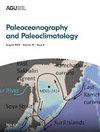利用单个有孔虫分析贝壳重塑对气候变异性重建的影响
IF 3.2
2区 地球科学
Q2 GEOSCIENCES, MULTIDISCIPLINARY
引用次数: 0
摘要
沉积物-水界面下底栖生物的颗粒混合(或称生物扰动)从根本上挑战了从深海沉积物岩芯中获取过去气候条件的代用记录。以往的研究主要针对生物扰动对从代用记录中获取的古海洋学变化性质的影响,而对季节和/或年际变化重建的影响则关注较少。我们介绍了 TurbIFA(跟踪有孔虫分析中再加工和生物扰动的不确定性),该软件调整并结合了现有算法,可定量估计沉积物再加工和其他不确定性的影响,并评估基于单个有孔虫分析(IFA)的海洋和气候变率重建的重要性。在以前利用水文气候-沉积物模拟对生物扰动进行理想化研究的基础上,TurbIFA 推进了 IFA 代理系统建模,使用户可以直接评估其数据对全球海洋贝壳再加工相关的各种局部参数的敏感性。TurbIFA 利用最先进的大气-海洋大气环流耦合模式的输出结果,模拟浮游有孔虫δ18O 或镁/钙-温度信号载体,并评估样本大小、分析方案以及生物扰动引起的不确定性。将 TurbIFA 应用于合成数据集和现有数据集表明,一旦全面评估了沉积物堆积速率、沉积物混合层深度、所选 IFA 采样间隔的时间长度以及气候变率(即目标环境信号)的变化等因素的影响,就可以评估基于 IFA 重建的意义。我们认为,TurbIFA 可以帮助对从古海洋记录中收集到的过去季节和年际变化进行定量评估。本文章由计算机程序翻译,如有差异,请以英文原文为准。
Shell Reworking Impacts on Climate Variability Reconstructions Using Individual Foraminiferal Analyses
Particle mixing by benthic fauna beneath the sediment‐water interface (or bioturbation) fundamentally challenges the proxy based retrieval of past climatic conditions from deep‐sea sediment cores. Previous efforts targeted the impacts of bioturbation on the nature of paleoceanographic changes gleaned from the proxy record, whereas impacts on seasonal and/or interannual variability reconstructions have received less attention. We present TurbIFA (Tracking uncertainty of reworking & bioturbation on IFA), a software that adapts and combines existing algorithms to quantitatively estimate the impact of sediment reworking and other uncertainties and assess significance of ocean and climate variability reconstructions based on individual foraminiferal analyses (IFA). Building upon previous idealized investigations of bioturbation using hydroclimate‐sediment simulations, TurbIFA advances the IFA proxy system modeling such that users may directly assess the sensitivity of their data to various local parameters related to shell reworking across the global ocean. Using the output of state‐of‐the‐art coupled atmosphere‐ocean general circulation models, TurbIFA simulates planktic foraminiferal δ18O or Mg/Ca‐temperature signal carriers and evaluates uncertainties in the sample size, analytical protocols along with as those arising from bioturbation. Application of TurbIFA to synthetic and existing data sets indicates that the significance of IFA‐based reconstructions can be assessed once the impacts of sediment accumulation rates, sediment mixed layer depths, length of time integrated by the chosen IFA sampling interval, and changes in the amplitude of climate variability (i.e., the targeted environmental signal) are comprehensively evaluated. We contend that TurbIFA can aid quantitative assessments of past seasonal and interannual variability gleaned from the paleoceanographic record.
求助全文
通过发布文献求助,成功后即可免费获取论文全文。
去求助
来源期刊

Paleoceanography and Paleoclimatology
Earth and Planetary Sciences-Atmospheric Science
CiteScore
6.20
自引率
11.40%
发文量
107
期刊介绍:
Paleoceanography and Paleoclimatology (PALO) publishes papers dealing with records of past environments, biota and climate. Understanding of the Earth system as it was in the past requires the employment of a wide range of approaches including marine and lacustrine sedimentology and speleothems; ice sheet formation and flow; stable isotope, trace element, and organic geochemistry; paleontology and molecular paleontology; evolutionary processes; mineralization in organisms; understanding tree-ring formation; seismic stratigraphy; physical, chemical, and biological oceanography; geochemical, climate and earth system modeling, and many others. The scope of this journal is regional to global, rather than local, and includes studies of any geologic age (Precambrian to Quaternary, including modern analogs). Within this framework, papers on the following topics are to be included: chronology, stratigraphy (where relevant to correlation of paleoceanographic events), paleoreconstructions, paleoceanographic modeling, paleocirculation (deep, intermediate, and shallow), paleoclimatology (e.g., paleowinds and cryosphere history), global sediment and geochemical cycles, anoxia, sea level changes and effects, relations between biotic evolution and paleoceanography, biotic crises, paleobiology (e.g., ecology of “microfossils” used in paleoceanography), techniques and approaches in paleoceanographic inferences, and modern paleoceanographic analogs, and quantitative and integrative analysis of coupled ocean-atmosphere-biosphere processes. Paleoceanographic and Paleoclimate studies enable us to use the past in order to gain information on possible future climatic and biotic developments: the past is the key to the future, just as much and maybe more than the present is the key to the past.
 求助内容:
求助内容: 应助结果提醒方式:
应助结果提醒方式:


